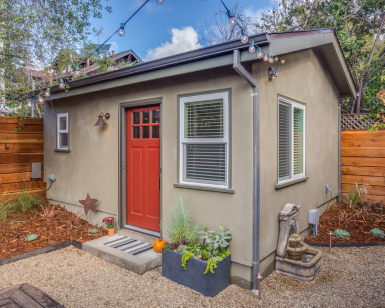San Rafael, CA – Marin County’s plan to address housing needs through 2031 will be presented to the Marin County Board of Supervisors on January 24 after consideration and final feedback from the County’s Planning Commission.
The housing needs plan, known as the Housing Element of the Countywide Plan, only affects housing considerations for the county’s unincorporated areas. Each city and town are developing their own plans. Housing Element updates are required by state law every eight years, and Marin’s newest one has a statutory deadline of January 31.
 Building an accessory dwelling unit (ADU) on existing property is one way to expand housing options in Marin County.
Building an accessory dwelling unit (ADU) on existing property is one way to expand housing options in Marin County.The online-only housing meeting is to begin at 5 p.m., preceded by a 3 p.m. online-only meeting about the environmental impacts and safety elements of the plan. Instructions on how to watch or participate in the 3 p.m. and 5 p.m. videoconference hearings are on the Board’s archive webpage.
The Marin County Community Development Agency (CDA) has worked on the Housing Element for more than a year and has hosted dozens of public meetings and Board updates. The Board of Supervisors met on December 6, 2022, to provide feedback on the sites list. Staff presented its list of potential zoning maps for future housing to a December 12 joint session of the Supervisors and Planning Commission, followed by separate Planning Commission session January 5.
For 2023-2032, the County must plan for at least 3,569 new units in unincorporated areas. Within that total, at least 1,734 must be designated as affordable to lower-income households, at least 512 for moderate-income households, and at least 1,323 for above-moderate-income households.
The County is devising ways to accommodate housing needs in one of the most expensive housing markets in the United States. Many elder adults and Marin’s workforce are struggling to pay rent and mortgage payments, causing a housing affordability and employment recruiting crisis. The County’s most recent housing needs assessment – a required step for the Housing Element update – showed that providing housing that would support Marin’s needs would require a shift from single-family detached homes toward development of attached units and townhomes, a point that was consistent with public outreach feedback. Today, more than 80% of Marin homes are single-family detached buildings, limiting housing options and escalating costs.
Not only have residents and nonprofits voiced consistent support to the County for more affordable housing in Marin, but state legislation has trended toward requiring municipalities to encourage and approve more multi-unit housing, especially within existing communities near public transit, schools, and commercial activity. Infill and dense development is key to reducing greenhouse gas emissions and protecting critical environmental resources and open space.
High housing costs resulting from a shortage of housing development near jobs and services is a longstanding problem in many parts of California, including Marin. In the past, governmental constraints such as zoning limitations and complex development review processes hampered efforts to create opportunities for diverse populations to live near their workplaces and communities. Removal of those constraints is considered a major goal moving forward.
At the January 5 meeting that lasted more than eight hours, the Planning Commission recommended that the Board approve the environmental review of the Housing Element, including the list of properties that could accommodate housing. It also recommended approval of the Safety Element of the Countywide Plan update and changes to the County’s Development Code by adding form-based code creating clear development standards for multi-unit buildings in different parts of the county. However, the commissioners did not recommend the draft Housing Element and took issue with details of the Countywide Plan and zoning amendments. The Board of Supervisors is required to consider the Commission’s recommendations but does not have to accept them.
Also, CDA staff acknowledged that a Board-approved and state-mandated Housing Element update would enable development of multifamily housing in some of the more than 20 recognized neighborhoods in unincorporated areas with adopted community plans. Staff has proposed policy language that would allow implementation of the Housing Element while still retaining the purpose, vision and overall approach of the community plans, which set direction on all aspects of managing growth and change in these communities.
There are stiff financial and governance consequences for towns, cities, and counties that fail to adopt an approved housing plan. If a jurisdiction does not plan to meet housing goals, it becomes ineligible for state funding to serve local transportation needs and may be subject to limitations on the public review process for housing developments. The state’s Housing Accountability Act of 1990 includes a so-called Builder’s Remedy. If the County does not adopt the update by January 31, an applicant can disregard all zoning and Countywide Plan standards. A noncompliant municipality also faces the possibility of funding cuts, forfeiture of housing grant eligibility, and fines. HCD has a new division that is designed to enforce accountability with housing needs.
Questions and comments can be emailed to staff and phone inquiries can be made to (415) 473-6269. Regular updates can be found on the Housing and Safety Elements update webpage.